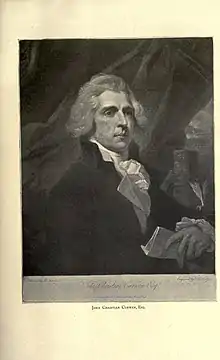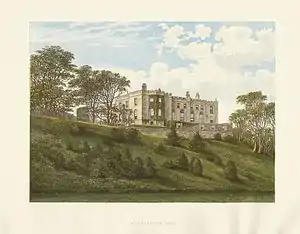John Christian Curwen
John Christian Curwen, born John Christian (12 July 1756 – 11 December 1828) was an English Member of Parliament and High Sheriff.[1]

Early life
He was born on 12 July 1756. He was the eldest surviving son of John Christian of Ewanrigg, Cumberland (now Cumbria) and Jane (née Curwen) Christian,[2] the daughter of Eldred Curwen of Workington Hall, Cumberland.[1]
He was educated at Peterhouse, Cambridge in 1773 before going on the Grand Tour between 1779 and 1782.[1]
Career
He succeeded his father in 1767 and served as High Sheriff of Cumberland from 1784 to 1785,[3] although he twice refused a peerage.[4]
He was elected Member of Parliament (MP) for Carlisle for 1786 to 1790 and again for 1791 to 1812 and for 1816 to 1820. He was then elected to represent the county seat of Cumberland. He was a member of the Whig party and an active campaigner in Parliament,[1] and known as something of a radical, having approved of the French Revolution.[4]
Personal life

He married twice. His first marriage was on 10 September 1775 to Margaret Taubman (d. 1778), the daughter of John Taubman, Speaker of the House of Keys, of Castletown, Isle of Man, with whom he had a son:[1]
- John Christian (1776–1852), who inherited Ewanrigg Hall and married Susanna Allen, daughter of Lewis Robert Allen of Dalston.[5]
His second marriage was on 5 October 1782 to his cousin Isabella Curwen, the daughter and heiress of Henry Curwen of Workington. On 6 March 1790, he took the name of Curwen after inheriting Workington Hall.[6] Workington Hall, now ruined after a wartime fire, is a Grade I listed building.[7] Together, John and Isabella were the parents of five sons and three daughters, including:[1]
- Henry Curwen (1783–1861), who inherited Workington Hall and married Jane Stanley.[5]
He died on 11 December 1828 in financial difficulties because of increased costs and reduced profits from his coal mines and was buried in an unmarked grave in Workington. At his death, he owed £118,334 and only £16,579 was owed to him.[1]
References
- "CURWEN (formerly CHRISTIAN), John Christian (1756–1828), of Ewanrigg and Workington Hall, Cumb". History of Parliament Online. Retrieved 16 May 2017.
- Cumberland and Westmorland Antiquarian and Archæological Society (1988). Publications: Extra series. T. Wilson. Retrieved 7 August 2019.
- "John Christian Curwen". www.npg.org.uk. National Portrait Gallery, London. Retrieved 7 August 2019.
- Hooper, Glenn (2001). The Tourist's Gaze: Travellers to Ireland, 1800-2000. Cork University Press. p. 24. ISBN 9781859183236. Retrieved 7 August 2019.
- Foster, Joseph (1884). The Royal Lineage of Our Noble and Gentle Families. Together With Their Paternal Ancestry. London, Hatchards. pp. 126–127. Retrieved 7 August 2019.
- Wordsworth, William (2008). The Fenwick Notes of William Wordsworth. Humanities-Ebooks. p. 225. ISBN 9781847600042. Retrieved 7 August 2019.
- Historic England. "Workington Hall (1144479)". National Heritage List for England. Retrieved 10 July 2015.
External links
- CURWEN (formerly CHRISTIAN), John Christian (1756-1828), of Ewanrigg and Workington Hall, Cumb. at the History of Parliament Online.
- Portrait of Curwen by John James Halls and the Manx Museum.
- Curwen, John Christian (1756-1828) MP, Papers at The National Archives.
| Parliament of Great Britain | ||
|---|---|---|
| Preceded by Sir John Lowther The Earl of Surrey |
Member of Parliament for Carlisle 1786–1790 With: The Earl of Surrey to November 1786 Edward Knubley November 1786 – 1787 Rowland Stephenson 1787–1790 |
Succeeded by James Clarke Satterthwaite Edward Knubley |
| Preceded by James Clarke Satterthwaite Edward Knubley |
Member of Parliament for Carlisle 1791–1800 With: Wilson Gale-Braddyll to 1796 Sir Frederick Fletcher-Vane, 2nd Bt from 1796 |
Succeeded by Parliament of the United Kingdom |
| Parliament of the United Kingdom | ||
| Preceded by Parliament of Great Britain |
Member of Parliament for Carlisle 1801–1812 With: Sir Frederick Fletcher-Vane, 2nd Baronet to 1802 Walter Spencer-Stanhope from 1802 |
Succeeded by Sir James Graham, 1st Bt Henry Fawcett |
| Preceded by Viscount Morpeth Sir John Lowther, 1st Bt |
Member of Parliament for Cumberland 1820–1829 With: Sir John Lowther, 1st Bt |
Succeeded by Sir James Graham, 2nd Bt Sir John Lowther, 1st Bt |